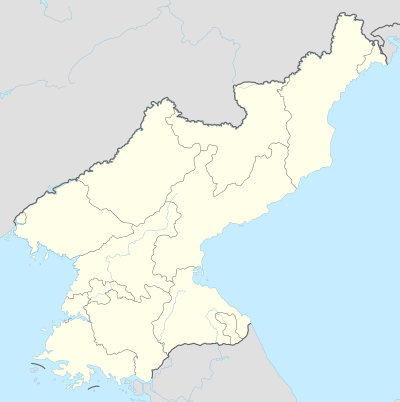Kangdong Residence
| Kangdong Residence | |
| Chosŏn'gŭl | 강동 관저 |
|---|---|
| Hancha | 江東官邸 |
| Revised Romanization | Gangdong Gwanjeo |
| McCune–Reischauer | Kangdong Kwanjŏ |

Kangdong Residence[1] is the summer retreat and second major residence of the North Korean leader Kim Jong-un besides Ryongsong Residence.[2]
Location
The residence is located in Kangdong-gun, a suburban county of Pyongyang, around 30 km (19 mi) northeast of Kim Il-sung Square.[3] Taedong River is just 1 km (0.62 mi) to the north.[4] The size of the whole leadership complex is around 4 km2 (1.5 sq mi). According to Kim Jong-il’s former bodyguard Lee Young-kuk there are at least eight North Korean leader’s residences outside Pyongyang.[5]
Description
The compound was constructed in the 1980s and expanded in the 1990s under the order of Kim Jong-il.[6] It contains buildings for Kim Jong-il, his late wife Ko Yong-hui, his sister Kim Kyong-hui and his brother-in-law Jang Sung-taek.[7] The area is mostly used as summer residence, to spend holidays[8] or for parties with close officials.[6] The estate has an elaborate garden, set around many lakes. There are numerous guest houses, and a banqueting hall.[9] The whole compound is a maximum security area, surrounded by two armored fence lines[10] with guards huts and checkpoints, clearly visible on satellite pictures.[11] Kim Jong-il’s former cook Kenji Fujimoto worked and lived in a guest house within the compound and provided some photographs dated 1989.[7] Analysis of satellite pictures showed that the area changed significantly since then and even after 2006 new buildings and a new railway station were established.[12] Defectors reported that in Hyangmok-ri, not far from the residence and from the Mausoleum of Tangun, Kim Jong-un’s birthplace is being built,[13] though he was actually born in Changsong, North Pyongan Province.[14]
Facilities
- Furnished entertainment facilities with bowling, shooting and roller-skating[7]
- Horse stables and a racing track[3]
- Football field[15]
- Kangdong airfield is 4 km (2.5 mi) south[9]
See also
- North Korean leader's residences
- Official residence
- Ryongsong Residence
- Sinuiju North Korean Leader's Residence
- North Korea Uncovered
References
- ↑ 이, 수경 (January 11, 2010). 김씨 왕조의 실체] 김정일의 호화 별장. Radio Free Asia (in Korean). Retrieved December 12, 2012.
- ↑ Ramstad, Evan (May 22, 2009). "Gulags, Nukes and a Water Slide: Citizen Spies Lift North Korea's Veil". The Wall Street Journal. Retrieved December 12, 2012.
- 1 2 "KWP Leadership Compound". Wikimapia. Retrieved December 12, 2012.
- ↑ Lubin, Gus (June 2, 2010). "House of the Day: The Countless Luxury Mansions Of Kim Jong Il". Business Insider. Retrieved December 12, 2012.
- ↑ Macintyre, Donald (February 18, 2002). "The Supremo in His Labyrinth". Time Magazine. Retrieved December 12, 2012.
- 1 2 "North Korean Special Weapons Facilities: Command and Control". Federation of American Scientists. Retrieved December 12, 2012.
- 1 2 3 Han, Young Jin (March 15, 2005). "Kim Jong Il, Where He Sleeps and Where He Works". DailyNK. Retrieved December 12, 2012.
- ↑ "Lavish Mansions of the Late North Korean Despot Kim Jong-Il". Curbed. Retrieved December 12, 2012.
- 1 2 Prynne, Miranda (June 21, 2009). "North Korea uncovered: Palaces, labour camps and mass graves". The Independent. Retrieved December 12, 2012.
- ↑ "North Korea by Google Earth: Kim Jong Il's Largest Palace". One Free Korea. Retrieved December 12, 2012.
- ↑ "North Korea Secret Places". LiveLeak. Retrieved December 12, 2012.
- ↑ "Kim family Kangdong compound updated". North Korea Economy Watch. Retrieved December 12, 2012.
- ↑ Kim, Yong Hun (July 22, 2011). "Idolization of Kim Jong Eun Began in January 2009". DailyNK. Retrieved December 12, 2012.
- ↑ Shin, Joo Hyun (October 14, 2010). "Kim Jong Eun Birth Manipulation Well Underway". DailyNK. Retrieved December 12, 2012.
- ↑ "Where KJI watches football–and recovers from adverse health events". North Korea Economy Watch. Retrieved December 12, 2012.
External links
- "North Korea Uncovered – (Google Earth)". North Korean Economy Watch. – Project for comprehensive mapping of North Korea
- "The Palaces of Pyongyang on Google Earth". One Free Korea. – Detailed satellite pictures of six North Korean leader’s residences
Coordinates: 39°12′05″N 126°01′14″E / 39.201381°N 126.020683°E